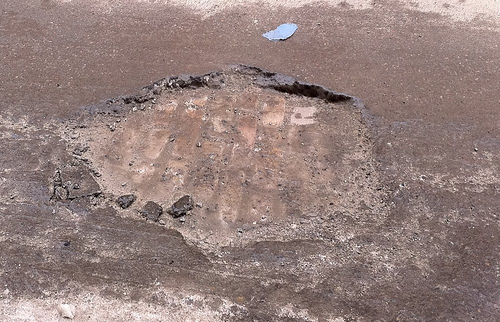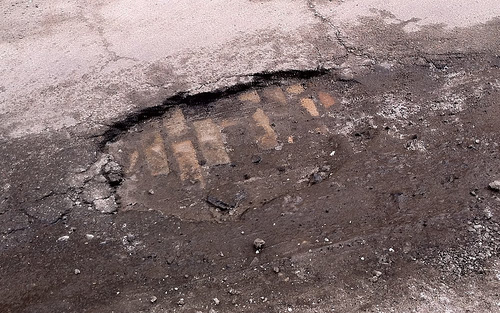
The Belgian Pavers (aka cobblestones) are showing through the pot holes on Chestnut Street in the Jewelry District. I wonder if there are any long lost streetcar tracks down there somewhere.


The Belgian Pavers (aka cobblestones) are showing through the pot holes on Chestnut Street in the Jewelry District. I wonder if there are any long lost streetcar tracks down there somewhere.

Jef is Greater City Providence's co-founder, editor, and publisher. He grew up on Cape Cod and lived in Boston; Portland, Maine; and New York before settling in Providence. In addition to urbanism, Jef is interested in art, design, and ice cream. Please feel free to contact Jef if you have any question or comments about Greater City Providence.
Work on Weybosset Street at PPAC Square is chugging right along.
RIDOT will be closing Chestnut Street at the old Route 195 overpass between June 15th and 29th for removal of the bridge.
RIDOT will close a portion of Richmond Street starting Monday, March 28th for 2-weeks to allow for the removal of the old Route 195 overpass.
Most streets in Providence still have the granite pavers underneath. I wonder when we’ll stop wasting money paving the side streets over and over, and just rip up the asphalt. Obviously the old streets are built better than what’s on top of them.
so…flash mob with pick axes anyone? I think the pavement will come up pretty easy, we’ll be left with beauty, and then the city won’t have to worry about filling the potholes.
I was so tempted to start trying to pry up the pavement when I took the photos. But it was way too cold.
Why don’t we use pavers anymore? They appear to have lasted longer than most asphalt and also allows for water drainage, slows down cars and obviously is more visually appealing.
I’m guessing snow removal is a problem on them. Think of a plow making a pothole. Now think of a plow hitting a bunch of pavers that have come loose.
Pavers are not great for bikes, not really great for pedestrians (especially people in wheelchairs) in crosswalks (another surface *could* be used in crosswalks I suppose), and they tend to be expensive to install (properly). That said, I think they could certainly be used more often on smaller streets that get less through traffic.
Of course I don’t think there is an example of blacktop being installed properly anywhere in Providence, so it is not like pavers are too hard to install and blacktop is easy.
anyone mark these on the pothole map yet?
@RunawayJim
There are plenty of plazas, markets, squares and streets across the world who still use pavers and who also probably get more accumulation then we do. Old Montreal; Meatpacking District, NYC; Thames Street, Newport; etc… Also, take a look at the paver side of Pine Street and West Fountain in Providence, those streets are pretty decent and considering the amount of snow removal we’ve had. Anywho…
Pavers aren’t suitable for every street, it’s true. But they are good for side streets that are less heavily travelled. They are more expensive to install initially, but in most cases in Providence we wouldn’t really need to install them, just rip up the badly laid asphalt that’s on top of them. As for them being bad for pedestrians…huh? Seems to me that most of the great pedestrian areas of the world are full of cobblestone.
It should be noted that a big part of the reason why the pavement here is so bad is the existence of the cobblestone below it. Think of it like painting over a surface that hasn’t been sanded. One material doesn’t adhere to the other, so the top layer comes off with a little wear. If you don’t rip up the stones, the pavement will never stick. So either we go back to stone, or we get rid of them altogether and repave.
They’re not good for pedestrians when not installed properly, i.e. Waterplace.
A place in Providence were pavers are installed well is Turks Head. The surface is fine except for where utility companies have torn them out and then just threw them back in the hole. Also, on Atwells at the arch, I think those are laid over a layer of concrete, the ones at Atwells and Dean were before they were removed recently.
I would be curious to know however what people in wheelchairs think about Turks Head.
Waterplace is awful for walking. I don’t know that it’s how they were installed, but rather what was used. They’re not flat enough on top or small enough.
The Turk’s Head area is fine, but I agree on the wheelchair comment. I’m sure it’s not easy.
I actually think the pavers, if installed properly, might be nice on the side streets to keep people from flying up and down them.
Even for half a block, Belgian blocks are terrible with bicycles. Perhaps when there’s room for bike lanes an asphalt bike lane could be situated next to a Belgian block roadway.
Belgian block streets do really slow traffic. The noise of tires moving over the blocks could be annoying in residential areas.
For pedestrians maybe a solution could be to grind the stone surface, so that it would be more uniform at least at crosswalks. Alternately, a crosswalk could be defined in a smoother material (asphalt or concrete), which would make the crosswalk stand out as the realm of the pedestrian.
Thanks for saying most of what I was going to say, Peter B.
Asphalt will take longer to break to break up if it is only used for the bike lane.
Buses are very hard on pavements too: Another way streetcars save infrastructure dollars in the long run.